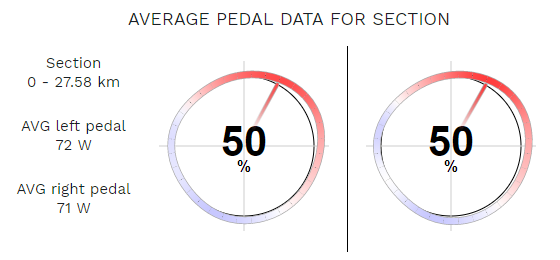AlexisBV
Active Member
Hello all,
So I finally decided to have a look at the advanced power metrics offered by the Powertap P1 pedals. I installed the Rouvy app on my android phone (since Powertap does not have an android app for those metrics ), and recorded yesterday's workout - a 1 hr indoor ride on a Tacx Neo trainer in Erg mode, following TrainerRoad's Tunnabora workout. The bike is a S30.
), and recorded yesterday's workout - a 1 hr indoor ride on a Tacx Neo trainer in Erg mode, following TrainerRoad's Tunnabora workout. The bike is a S30.
Data:
And here are the advanced power meter metrics, with a quick explanation of each:
Red color indicates useful force is applied at that point in the pedal stroke (in the direction of rotation). White is neutral, blue means drag, or the foot is actually applying force in the wrong direction, against rotation. The more intense the color, the more intense the force.
The further away the colored band is from the black circle, the more radial force (useless) is being applied.
This one shows the angle of the pedal at each position in the pedal stroke. I'm surprised it indicates the pedal is actually pointing down in the return stroke, which is not the case according to an older video I shot of myself pedalling in slow motion (link at the end of this post), so there's probably some kind of angle offset there.
This graph more explicitely shows the direction of the force being applied on the pedals at each point in the stroke. As in the first graph, we can see that the bulk of the force, which is horizontal (pushing forward), actually happens around the 1 o'clock and 2 o'clock positions in the pedal stroke, so some of that force is being wasted as a radial component ("stretching" the crank).
Analysis:
With the above in mind, it would appear I'm applying force too late in the pedal stroke. Also, during the return stroke, maybe I'm letting too much leg weight onto the pedal, which pushes it against the direction of rotation.
So, on one had, I should improve my pedal stroke (with some focus on the return to do a proper pull and a proper kick upwards at 9 o'clock). But, on the other hand, I'm asking myself if I should stretch the boom a bit further, so that the power stroke happens earlier, nearer to the 12 o'clock position, so more (if not all) of the force is actually in the tangential (useful) direction.
Also, the fact that the chainrings are Qrings might be relevant. They're setup in position 3.
Any thoughts?
FWIW here's the slomo video of the setup, although the video was taken several months ago and I might have tweaked the boom position since.
So I finally decided to have a look at the advanced power metrics offered by the Powertap P1 pedals. I installed the Rouvy app on my android phone (since Powertap does not have an android app for those metrics
Data:
And here are the advanced power meter metrics, with a quick explanation of each:
Red color indicates useful force is applied at that point in the pedal stroke (in the direction of rotation). White is neutral, blue means drag, or the foot is actually applying force in the wrong direction, against rotation. The more intense the color, the more intense the force.
The further away the colored band is from the black circle, the more radial force (useless) is being applied.
This one shows the angle of the pedal at each position in the pedal stroke. I'm surprised it indicates the pedal is actually pointing down in the return stroke, which is not the case according to an older video I shot of myself pedalling in slow motion (link at the end of this post), so there's probably some kind of angle offset there.
This graph more explicitely shows the direction of the force being applied on the pedals at each point in the stroke. As in the first graph, we can see that the bulk of the force, which is horizontal (pushing forward), actually happens around the 1 o'clock and 2 o'clock positions in the pedal stroke, so some of that force is being wasted as a radial component ("stretching" the crank).
Analysis:
With the above in mind, it would appear I'm applying force too late in the pedal stroke. Also, during the return stroke, maybe I'm letting too much leg weight onto the pedal, which pushes it against the direction of rotation.
So, on one had, I should improve my pedal stroke (with some focus on the return to do a proper pull and a proper kick upwards at 9 o'clock). But, on the other hand, I'm asking myself if I should stretch the boom a bit further, so that the power stroke happens earlier, nearer to the 12 o'clock position, so more (if not all) of the force is actually in the tangential (useful) direction.
Also, the fact that the chainrings are Qrings might be relevant. They're setup in position 3.
Any thoughts?
FWIW here's the slomo video of the setup, although the video was taken several months ago and I might have tweaked the boom position since.









